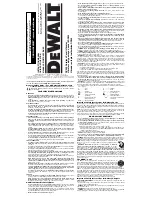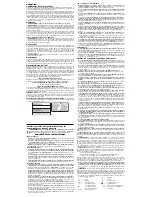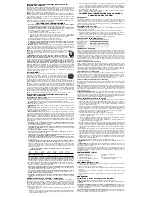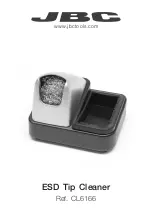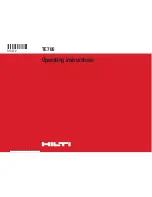
IF YOU HAVE ANY QUESTIONS OR COMMENTS ABOUT THIS OR ANY D
E
WALT TOOL,
CALL US TOLL FREE AT:
1-800-4-D
E
WALT (1-800-433-9258)
General Safety Rules – For All Battery Operated Tools
WARNING! Read and understand all instructions.
Failure to follow all
instructions listed below may result in electric shock, fire and/or serious
personal injury.
SAVE THESE INSTRUCTIONS
WORK AREA
•
Keep your work area clean and well lit.
Cluttered benches and dark areas invite accidents.
•
Do not operate power tools in explosive atmospheres, such as in the presence of
flammable liquids, gases, or dust.
Power tools create sparks which may ignite the dust
or fumes.
•
Keep bystanders, children, and visitors away while operating a power tool.
Distractions can cause you to lose control.
ELECTRICAL SAFETY
•
Do not abuse the cord. Never use the cord to carry the tool. Keep cord away from
heat, oil, sharp edges or moving parts. Replace damaged cords immediately.
Damaged cords may create a fire.
•
A battery operated tool with integral batteries or a separate battery pack must be
recharged only with the specified charger for the battery.
A charger that may be suit-
able for one type of battery may create a risk of fire when used with another battery.
•
Use battery operated tool only with the specifically designed battery pack.
Use of any
other batteries may create a risk of fire.
PERSONAL SAFETY
•
Stay alert, watch what you are doing and use common sense when operating a
power tool. Do not use tool while tired or under the influence of drugs, alcohol, or
medication.
A moment of inattention while operating power tools may result in serious per-
sonal injury,
•
Dress properly. Do not wear loose clothing or jewelry. Contain long hair. Keep your
hair, clothing, and gloves away from moving parts.
Loose clothing, jewelry, or long hair
can be caught in moving parts. Air vents often cover moving parts and should also be
avoided.
•
Avoid accidental starting. Be sure switch is in the locked or off position before
inserting battery pack.
Carrying tools with your finger on the switch or inserting the bat-
tery pack into a tool with the switch on invites accidents.
•
Remove adjusting keys or wrenches before turning the tool on.
A wrench or key that
is left attached to a rotating part of the tool may result in personal injury.
•
Do not overreach. Keep proper footing and balance at all times.
Proper footing and bal-
ance enables better control of the tool in unexpected situations.
•
Use safety equipment. Always wear eye protection.
Dust mask, non-skid safety shoes,
hard hat, or hearing protection must be used for appropriate conditions.
TOOL USE AND CARE
•
Use clamps or other practical way to secure and support the workpiece to a stable
platform.
Holding the work by hand or against your body is unstable and may lead to a loss
of control.
•
Do not force tool. Use the correct tool for your application.
The correct tool will do the
job better and safer at the rate for which it is designed.
•
Do not use tool if switch does not turn it on or off.
Any tool that cannot be controlled
with the switch is dangerous and must be repaired.
•
Disconnect battery pack from tool or place the switch in the locked or off position
before making any adjustments, changing accessories, or storing the tool.
Such
preventative safety measures reduce the risk of starting the tool accidentally.
•
Store idle tools out of reach of children and other untrained persons.
Tools are dan-
gerous in the hands of untrained users.
•
When battery pack is not in use, keep it away from other metal objects like: paper
clips, coins, keys, nails, screws, or other small metal objects that can make a con-
nection from one terminal to another.
Shorting the battery terminals together may cause
sparks, burns, or a fire.
•
Maintain tools with care. Keep cutting tools sharp and clean.
Properly maintained
tools, with sharp cutting edges are less likely to bind and are easier to control.
•
Check for misalignment or binding of moving parts, breakage of parts, and any other
condition that may affect the tool’s operation. If damaged, have the tool serviced
before using.
Many accidents are caused by poorly maintained tools.
•
Use only accessories that are recommended by the manufacturer for your model.
Accessories that may be suitable for one tool, may become hazardous when used on
another tool.
SERVICE
•
Tool service must be performed only by qualified repair personnel.
Service or main-
tenance performed by unqualified personnel could result in a risk of injury.
•
When servicing a tool, use only identical replacement parts. Follow instructions in
the Maintenance section of this manual.
Use of unauthorized parts or failure to follow
Maintenance Instructions may create a risk of electric shock or injury.
Additional Specific Safety Rules
•
Do not operate this tool for long periods of time.
Vibration caused by the operating
action of this tool may cause permanent injury to fingers, hands, and arms. Use gloves to
provide extra cushion, take frequent rest periods, and limit daily time of use.
•
Do not hold flex-shaft casing when in use.
It is not insulated and may become
electrically charged if it comes into contact with an electrical source. Hold the tool only by
the plastic handle and housing to prevent electric shock.
•
Make sure hands are not wet when using tool.
INSTRUCTION MANUAL
GUIDE D'UTILISA
TION
MANUAL
DE INSTRUCCIONES
DC530 Cordless Pencil V
ibrator
V
ibrateur de type crayon sans fil DC530
V
ibrador en lápiz inalámbrico DC530
INSTRUCTIVO DE OPERACIÓN, CENTROS DE SER
VICIO
Y
PÓLIZA
DE GARANTÍA.
ADVERTENCIA:
LÉASE ESTE
INSTRUCTIVO
ANTES DE USAR EL
PRODUCT
O.
D
E
WALT Industrial Tool Co., 701 East Joppa Road, Baltimore, MD 21286
(JUL06) Form 640407-00 DC530 Copyright © 2005, 2006 D
E
WALT
The following are trademarks for one or more D
E
WALT power tools: the yellow and black color scheme; the “D” shaped
air intake grill; the array of pyramids on the handgrip; the kit box configuration; and the array of lozenge-shaped humps
on the surface of the tool.
•
Keep hands away from moving parts.
Never place your hands near the vibrator head.
•
Do not hold vibrator head when starting the tool or during operation.
Serious
personal injury may result.
•
Ensure switch is in the OFF position and disconnect battery pack before cleaning the
vibrator head or flex-shaft casing.
•
Use gloves when cleaning the vibrator head.
Concrete is caustic and may cause
personal injury.
•
Keep hands and body parts clear of immediate work area.
•
Do not overreach.
Maintain proper footing and balance at all times. This enables better
control of the tool in unexpected situations.
•
Use both hands for safe handling of this tool
(Fig. 8). This tool should not be used while
standing on a ladder.
•
This tool is intended only for vibrating concrete.
Any other use of the product may
cause serious personal injury.
•
Actuating tool may result in flying debris, collation material or dust which could
harm operator’s eyes.
The operator and all those persons in the general area should wear
approved safety glasses with permanently attached side shields. Approved safety glasses
are imprinted with the characters “Z87.1”. It is the employer’s responsibility to enforce the
use of eye protection equipment by the tool operator and other people in the work area.
•
Actuating tool may result in flying debris, collation material or dust which could
harm operator’s eyes.
To minimize risk of flying debris only operate tool while vibrator
head is fully submerged in the wet, mixed, poured concrete.
•
Do not use tool in a concrete mixer.
Serious personal Injury may result
•
Disconnect battery pack from the tool whenever assembling or disassembling the
tool, performing any maintenance or repair, moving the tool or when the tool is
unattended.
•
When assembling or disassembling the flex-shaft casing from the power unit, the
internal flex-shaft core may act like a spring.
Slowly separate flex-shaft core from the
flex shaft casing, while wearing eye protection and gloves to prevent personal injury.
•
Do not alter or modify the tool in any way.
•
Do not use tool in or around grain hoppers, flammable dust, gases or fumes.
The tool
may produce a spark that could ignite gases causing an explosion.
•
Do not point the tool at co-workers or yourself at any time.
No horseplay! Work safe!
Respect the tool as a working implement.
CAUTION: Wear appropriate personal hearing protection during use.
Under some
conditions and duration of use, noise from this product may contribute to hearing loss.
CAUTION: When not in use, place tool on its side on a stable surface where it will not
cause a tripping or falling hazard.
Some tools with large battery packs will stand upright on
the battery pack but may be easily knocked over.
WARNING:
Contact with wet (unhardened) concrete, mortar, cement, or cement mixtures
can cause skin irritation, severe chemical burns (third degree), or serious eye damage. Wear
waterproof gloves, a long-sleeved shirt, full-length trousers, and proper eye protection when
working with these materials. Wash wet concrete, mortar, cement or cement mixtures from
your skin immediately. Flush eyes immediately after contact. Seek immediate medical
attention if you have persistent irritation.
WARNING:
Some dust created by power sanding, sawing, grinding, drilling, and other
construction activities contains chemicals known to cause cancer, birth defects or other
reproductive harm. Some examples of these chemicals are:
• lead from lead-based paints,
• crystalline silica from bricks and cement and other masonry products, and
• arsenic and chromium from chemically-treated lumber (CCA).
Your risk from these exposures varies, depending on how often you do this type of work. To
reduce your exposure to these chemicals: work in a well ventilated area, and work with
approved safety equipment, such as those dust masks that are specially designed to filter out
microscopic particles.
•
Avoid prolonged contact with dust from power sanding, sawing, grinding, drilling,
and other construction activities. Wear protective clothing and wash exposed areas
with soap and water.
Allowing dust to get into your mouth, eyes, or lay on the skin may
promote absorption of harmful chemicals.
WARNING:
Use of this tool can generate and/or disburse dust, which may cause serious
and permanent respiratory or other injury. Always use NIOSH/OSHA approved respiratory
protection appropriate for the dust exposure. Direct particles away from face and body.
•
The label on your tool may include the following symbols. The symbols and their definitions
are as follows:
V ..................volts
A ..................amperes
Hz ................hertz
W..................watts
min ..............minutes
................alternating current
............direct current
no ................no load speed
................Class I Construction
..................earthing terminal
....................
(grounded)
................safety alert symbol
..................Class II Construction
…/min ..........revolutions or reciprocation
....................
(double insulated)
....................
per minute
BPM ............beats per minute
Important Safety Instructions for Battery Packs
Your tool uses an 18.0 Volt D
E
WALT battery pack. When ordering replacement battery packs,
be sure to include catalog number and voltage: Extended Run-Time battery packs deliver more
run-time than standard battery packs. Consult the chart at the end of this manual for compati-
bility of chargers and battery packs.
NOTE:
Your tool will accept either standard or Extended Run Time battery packs. However, be
sure to select proper voltage. Batteries slowly lose their charge when they are not on the
charger, the best place to keep your battery is on the charger at all times.
The battery pack is not fully charged out of the carton. Before using the battery pack and
charger, read the safety instructions below. Then follow charging procedures outlined.
READ ALL INSTRUCTIONS
•
Do not incinerate the battery pack even if it is severely damaged or is completely
worn out.
The battery pack can explode in a fire.
•
A small leakage of liquid from the battery pack cells may occur under extreme usage
or temperature conditions.
This does not indicate a failure. However, if the outer seal is
broken and this leakage gets on your skin:
a. Wash quickly with soap and water.
b. Neutralize with a mild acid such as lemon juice or vinegar.
c. If battery liquid gets into your eyes, flush them with clean water for a minimum of 10
minutes and seek immediate medical attention. (
Medical note:
The liquid is 25-35%
solution of potassium hydroxide.)
•
Charge the battery packs only in D
E
WALT chargers.
•
DO NOT
splash or immerse in water or other liquids.
•
Do not store or use the tool and battery pack in locations where the temperature may
reach or exceed 105°F (such as outside sheds or metal buildings in summer).
DANGER:
Electrocution hazard. Never attempt to open the battery pack for any reason. If
battery pack case is cracked or damaged, do not insert into charger. Electric shock or electro-
cution may result. Damaged battery packs should be returned to service center for recycling.
NOTE:
Battery storage and carrying caps are provided for use whenever the
battery is out of the tool or charger. Remove cap before placing battery in
charger or tool.
WARNING: Fire hazard. Do not store or carry battery so that metal
objects can contact exposed battery terminals.
For example, do not place
battery in aprons, pockets, tool boxes, product kit boxes, drawers, etc., with loose
nails, screws, keys, etc. without battery cap.
Transporting batteries can possibly cause
fires if the battery terminals inadvertently come in contact with conductive materials
such as keys, coins, hand tools and the like.
The US Department of Transportation
Hazardous Material Regulations (HMR) actually prohibit transporting batteries in commerce or
on airplanes (i.e., packed in suitcases and carry-on luggage) UNLESS they are properly
protected from short circuits. So when transporting individual batteries, make sure that the
battery terminals are protected and well insulated from materials that could contact them and
cause a short circuit.
The RBRC™ Seal
The RBRC™ (Rechargeable Battery Recycling Corporation) Seal on the
nickel cadmium and nickel metal hydride batteries (or battery packs) indicate that
the costs to recycle these batteries (or battery packs) at the end of their useful life
have already been paid by D
E
WALT. In some areas, it is illegal to place spent
nickel cadmium and nickel metal hydride batteries in the trash or municipal solid
waste stream and the RBRC program provides an environmentally conscious alternative.
RBRC™ in cooperation with D
E
WALT and other battery users, has established programs in
the United States and Canada to facilitate the collection of spent nickel cadmium and nickel
metal hydride batteries. Help protect our environment and conserve natural resources by
returning the spent nickel cadmium and nickel metal hydride batteries to an authorized
D
E
WALT service center or to your local retailer for recycling. You may also contact your local
recycling center for information on where to drop off the spent battery.
RBRC™ is a registered trademark of the
Rechargeable Battery Recycling Corporation.
Important Safety Instructions for Battery Chargers
SAVE THESE INSTRUCTIONS:
This manual contains important safety instructions for
battery chargers.
•
Before using charger, read all instructions and cautionary markings on charger, battery
pack, and product using battery pack.
DANGER:
Electrocution hazard. 120 volts are present at charging terminals. Do not probe
with conductive objects.
WARNING:
Shock hazard. Do not allow any liquid to get inside charger.
CAUTION:
Burn hazard. To reduce the risk of injury, charge only D
E
WALT rechargeable
batteries. Other types of batteries may burst causing personal injury and damage.
If you have questions or comments, contact us.
Pour toute question ou tout commentaire, nous contacter
.
Si tiene dudas o comentarios, contáctenos.
1-800-4-D
E
W
A
L
T
• www
.dewalt.com

